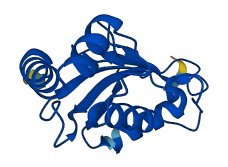P52490
Gene name |
UBC13 (YDR092W, YD6652.04) |
Protein name |
Ubiquitin-conjugating enzyme E2 13 |
Names |
E2 ubiquitin-conjugating enzyme 13, Ubiquitin carrier protein 13, Ubiquitin-protein ligase 13 |
Species |
Saccharomyces cerevisiae (strain ATCC 204508 / S288c) (Baker's yeast) |
KEGG Pathway |
sce:YDR092W |
EC number |
2.3.2.23: Aminoacyltransferases |
Protein Class |
|

Descriptions
The autoinhibited protein was predicted that may have potential autoinhibitory elements via cis-regPred.
Autoinhibitory domains (AIDs)
Target domain |
|
Relief mechanism |
|
Assay |
cis-regPred |
Accessory elements
No accessory elements
Autoinhibited structure

Activated structure

8 structures for P52490
2 variants for P52490
| Variant ID(s) | Position | Change | Description | Diseaes Association | Provenance |
|---|---|---|---|---|---|
| s04-630489 | 117 | P>S | No | SGRP | |
| s04-630568 | 143 | W>L | No | SGRP |
No associated diseases with P52490
Functions
| Description | ||
|---|---|---|
| EC Number | 2.3.2.23 | Aminoacyltransferases |
| Subcellular Localization |
|
|
| PANTHER Family | ||
| PANTHER Subfamily | ||
| PANTHER Protein Class | ||
| PANTHER Pathway Category | No pathway information available | |
6 GO annotations of cellular component
| Name | Definition |
|---|---|
| cytoplasm | The contents of a cell excluding the plasma membrane and nucleus, but including other subcellular structures. |
| cytosol | The part of the cytoplasm that does not contain organelles but which does contain other particulate matter, such as protein complexes. |
| fungal-type vacuole membrane | The lipid bilayer surrounding a vacuole, the shape of which correlates with cell cycle phase. The membrane separates its contents from the cytoplasm of the cell. An example of this structure is found in Saccharomyces cerevisiae. |
| nucleus | A membrane-bounded organelle of eukaryotic cells in which chromosomes are housed and replicated. In most cells, the nucleus contains all of the cell's chromosomes except the organellar chromosomes, and is the site of RNA synthesis and processing. In some species, or in specialized cell types, RNA metabolism or DNA replication may be absent. |
| UBC13-MMS2 complex | A heterodimeric ubiquitin conjugating enzyme complex that catalyzes assembly of K63-linked polyubiquitin chains, which act as a signal to promote error-free DNA postreplication repair; in Saccharomyces the complex comprises Ubc13p and Mms2p. |
| ubiquitin conjugating enzyme complex | Any complex that possesses ubiquitin conjugating enzyme activity. |
2 GO annotations of molecular function
| Name | Definition |
|---|---|
| ATP binding | Binding to ATP, adenosine 5'-triphosphate, a universally important coenzyme and enzyme regulator. |
| ubiquitin conjugating enzyme activity | Isoenergetic transfer of ubiquitin from one protein to another via the reaction X-ubiquitin + Y -> Y-ubiquitin + X, where both the X-ubiquitin and Y-ubiquitin linkages are thioester bonds between the C-terminal glycine of ubiquitin and a sulfhydryl side group of a cysteine residue. |
5 GO annotations of biological process
| Name | Definition |
|---|---|
| free ubiquitin chain polymerization | The process of creating free ubiquitin chains, compounds composed of a large number of ubiquitin monomers. These chains are not conjugated to a protein. |
| postreplication repair | The conversion of DNA-damage induced single-stranded gaps into large molecular weight DNA after replication. Includes pathways that remove replication-blocking lesions in conjunction with DNA replication. |
| protein K63-linked ubiquitination | A protein ubiquitination process in which a polymer of ubiquitin, formed by linkages between lysine residues at position 63 of the ubiquitin monomers, is added to a protein. K63-linked ubiquitination does not target the substrate protein for degradation, but is involved in several pathways, notably as a signal to promote error-free DNA postreplication repair. |
| protein polyubiquitination | Addition of multiple ubiquitin groups to a protein, forming a ubiquitin chain. |
| protein targeting to vacuolar membrane | The process of directing proteins towards the vacuolar membrane; usually uses signals contained within the protein. |
3 homologous proteins in AiPD
| UniProt AC | Gene Name | Protein Name | Species | Evidence Code |
|---|---|---|---|---|
| P21734 | UBC1 | Ubiquitin-conjugating enzyme E2 1 | Saccharomyces cerevisiae (strain ATCC 204508 / S288c) (Baker's yeast) | PR |
| P33296 | UBC6 | Ubiquitin-conjugating enzyme E2 6 | Saccharomyces cerevisiae (strain ATCC 204508 / S288c) (Baker's yeast) | PR |
| P35128 | ben | Ubiquitin-conjugating enzyme E2 N | Drosophila melanogaster (Fruit fly) | PR |
| 10 | 20 | 30 | 40 | 50 | 60 |
| MASLPKRIIK | ETEKLVSDPV | PGITAEPHDD | NLRYFQVTIE | GPEQSPYEDG | IFELELYLPD |
| 70 | 80 | 90 | 100 | 110 | 120 |
| DYPMEAPKVR | FLTKIYHPNI | DRLGRICLDV | LKTNWSPALQ | IRTVLLSIQA | LLASPNPNDP |
| 130 | 140 | 150 | |||
| LANDVAEDWI | KNEQGAKAKA | REWTKLYAKK | KPE |